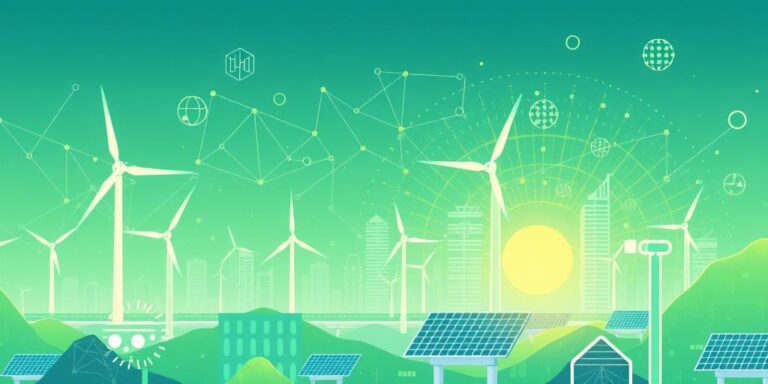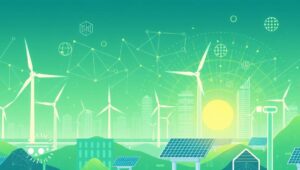AI for Climate Change: Solutions for a Greener Future (2025-2035)
Climate change is one of the most pressing issues facing humanity. The period between 2025 and 2035 will be critical in determining the long-term impacts of climate change and implementing effective mitigation and adaptation strategies. Artificial intelligence (AI) offers powerful tools to address various aspects of climate change, from monitoring and prediction to developing sustainable solutions. This article explores how AI can be leveraged to create a greener and more sustainable future.
1. AI for Climate Monitoring and Prediction
One of the most significant contributions of AI in the fight against climate change is its ability to monitor and predict environmental changes with high precision. AI algorithms can analyze vast datasets from satellites, sensors, and climate models to identify patterns and trends that would be impossible for humans to detect.
- Satellite Data Analysis: AI can process satellite imagery to monitor deforestation, track changes in ice cover, and assess the health of ecosystems. For instance, AI models can identify illegal logging activities in real-time, enabling timely intervention.
- Climate Modeling: AI can improve the accuracy of climate models by incorporating more data and refining prediction algorithms. This allows for more reliable forecasts of future climate scenarios, helping policymakers and businesses make informed decisions.
- Sensor Networks: AI can analyze data from sensor networks to monitor air and water quality, track greenhouse gas emissions, and detect pollution sources. This data can be used to enforce environmental regulations and identify areas that require immediate attention.
2. AI for Renewable Energy Optimization
Renewable energy sources like solar and wind are crucial for reducing our reliance on fossil fuels. AI can optimize the efficiency and reliability of renewable energy systems, making them more competitive with traditional energy sources.
- Smart Grids: AI can manage and optimize the distribution of electricity in smart grids, ensuring that renewable energy is used efficiently and effectively. AI algorithms can predict energy demand, balance supply and demand, and prevent grid outages.
- Predictive Maintenance: AI can predict when renewable energy equipment, such as wind turbines and solar panels, needs maintenance. This reduces downtime and increases the lifespan of these assets, making renewable energy more cost-effective.
- Energy Storage: AI can optimize the operation of energy storage systems, such as batteries, to ensure that renewable energy is available when it is needed most. This helps to overcome the intermittency of renewable energy sources and improve grid stability.
3. AI for Sustainable Agriculture
Agriculture is a significant contributor to greenhouse gas emissions and environmental degradation. AI can help make agriculture more sustainable by optimizing resource use, reducing waste, and improving crop yields.
- Precision Farming: AI-powered precision farming techniques use data from sensors, drones, and satellites to optimize irrigation, fertilization, and pest control. This reduces the use of water, fertilizers, and pesticides, minimizing environmental impact.
- Crop Monitoring: AI can monitor crop health and predict yields, helping farmers make better decisions about planting, harvesting, and storage. This reduces food waste and increases the efficiency of agricultural operations.
- Livestock Management: AI can optimize livestock management by monitoring animal health, improving feeding practices, and reducing methane emissions. This makes livestock farming more sustainable and reduces its environmental footprint.
4. AI for Carbon Capture and Storage
Carbon capture and storage (CCS) technologies are essential for reducing atmospheric CO2 levels. AI can improve the efficiency and effectiveness of CCS processes, making them more viable and scalable.
- Material Discovery: AI can accelerate the discovery of new materials for capturing CO2, making CCS technologies more efficient and cost-effective.
- Process Optimization: AI can optimize the operation of CCS plants by monitoring and controlling various parameters, such as temperature, pressure, and flow rates. This improves the efficiency of CO2 capture and storage.
- Leak Detection: AI can detect leaks in CO2 pipelines and storage sites, ensuring the safe and reliable operation of CCS systems.
5. AI for Sustainable Transportation
The transportation sector is a major source of greenhouse gas emissions. AI can help make transportation more sustainable by optimizing traffic flow, promoting the use of electric vehicles, and developing autonomous vehicles.
- Traffic Management: AI can optimize traffic flow by analyzing real-time data from sensors and cameras, reducing congestion and emissions.
- Electric Vehicle Optimization: AI can optimize the charging of electric vehicles, ensuring that they are charged at times when renewable energy is most available. This reduces the carbon footprint of electric vehicles.
- Autonomous Vehicles: AI can enable the development of autonomous vehicles, which can reduce fuel consumption, improve safety, and make transportation more efficient.
Challenges and Opportunities
While AI offers tremendous potential for addressing climate change, there are also challenges that need to be addressed. These include the need for large datasets, the risk of bias in AI algorithms, and the potential for unintended consequences.
- Data Availability: AI models require large datasets to be trained effectively. Ensuring that high-quality data is available and accessible is crucial for the successful deployment of AI in climate change applications.
- Algorithmic Bias: AI algorithms can perpetuate and amplify existing biases if they are trained on biased data. It is important to ensure that AI models are fair, transparent, and accountable.
- Ethical Considerations: The use of AI in climate change applications raises ethical considerations, such as the potential for job displacement and the impact on privacy. It is important to address these issues proactively to ensure that AI is used responsibly.
Conclusion
AI offers powerful tools for addressing climate change and creating a greener future. By leveraging AI for climate monitoring, renewable energy optimization, sustainable agriculture, carbon capture, and sustainable transportation, we can significantly reduce greenhouse gas emissions and mitigate the impacts of climate change. While there are challenges that need to be addressed, the potential benefits of AI in the fight against climate change are enormous. The period between 2025 and 2035 will be critical in harnessing the power of AI to create a more sustainable and resilient world.
This article provides an informative overview of the applications of AI in climate change mitigation and adaptation, highlighting key strategies and technologies for a greener future.




